Local Transport Guide: Metro, Skytrain & Tuk-Tuk Tips
Did you know using public transportation can cut your travel costs and reduce carbon emissions? Navigating a new city can be tough, but our tips will help you become a pro traveller.
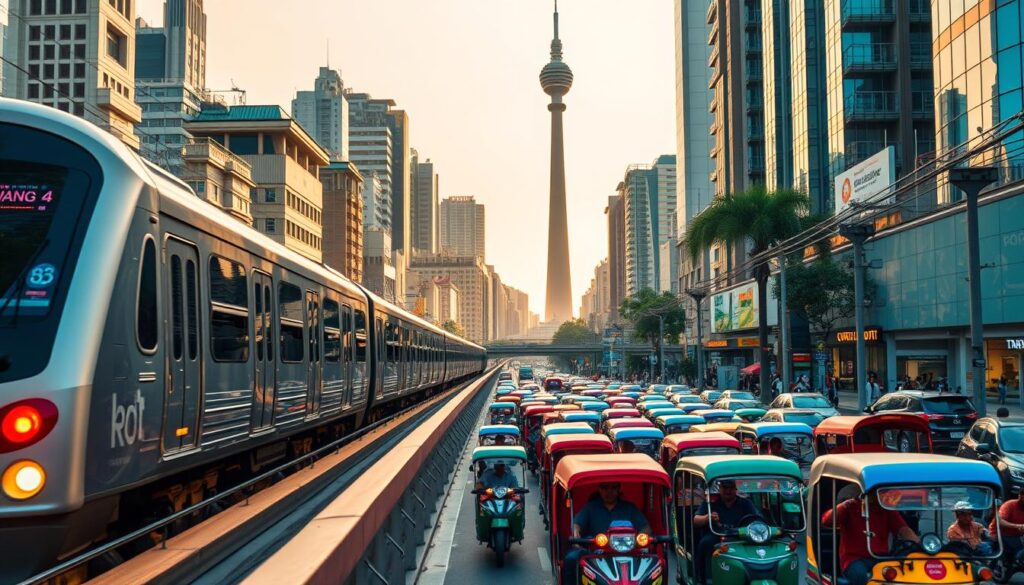
The metro is efficient, while a tuk-tuk ride is exciting. Each transportation service has its own perks. Our guide will show you how to travel like a local.
Discover how to use the skytrain and other transportation options. Make smart choices for your travels. Whether you’re experienced or new to travel, our guide supports you at every step.
Understanding Public Transport Systems
Exploring Bangkok’s streets can be easy if you know the public transport system. Bangkok has a great network of public transport. It lets both tourists and locals move around the city quickly and at a low cost.
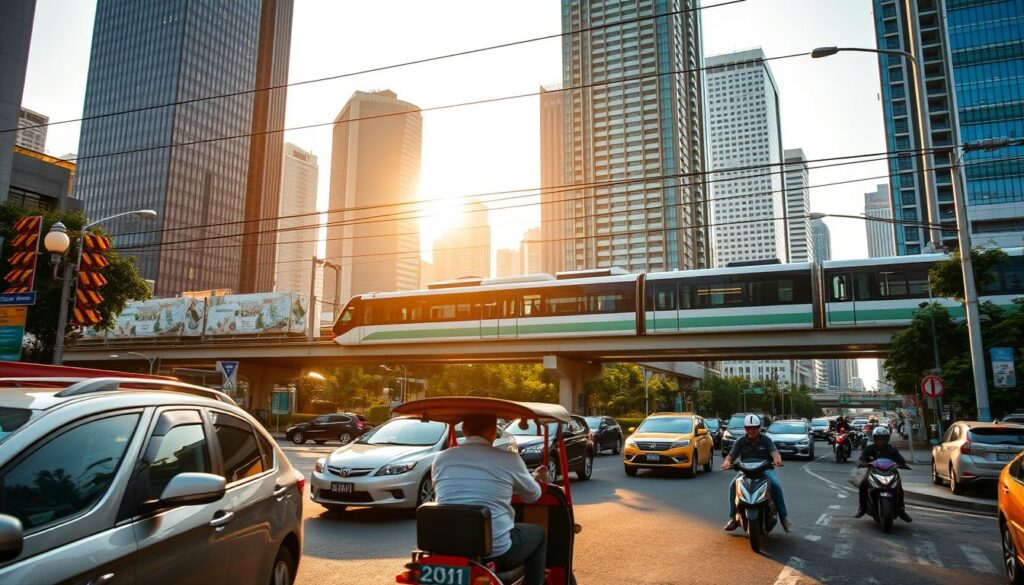
Differences Between Metro and Skytrain
The metro and skytrain are Bangkok’s main public transport options. The metro is underground and good for long trips. On the other hand, the skytrain is elevated and offers a view of the city. Knowing the difference helps you pick the best way to travel.
When to Choose Public Transit
Public transit is great for experiencing local culture and saving money. It’s also handy during busy times when roads are full. Using public transport means no driving or parking worries, making travel easier.
Benefits of Using Public Transport
Public transport in Bangkok is cheap and convenient. It lets you travel the city without a car. Plus, it helps cut down on traffic and pollution, making it good for the environment.
Navigating Local Metro Systems
To really get to know a city, you must learn its metro system. This includes how to buy passes and use the map. The Bangkok MRT, or Mass Rapid Transit, is a great example. It has 18 stations that link important parts of the city.
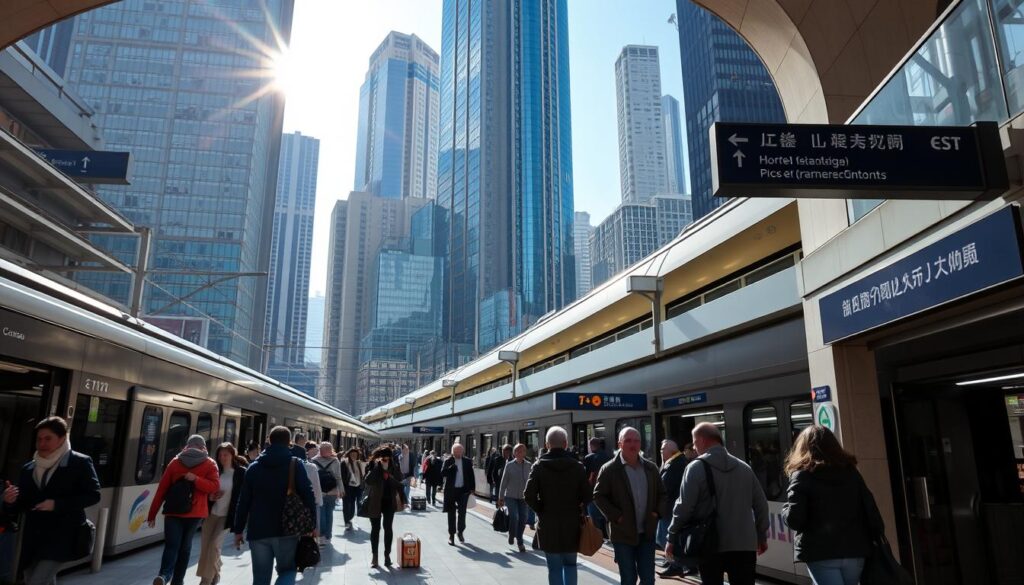
Buying Metro Passes
First, you need to buy a ticket or pass. Most metro systems have different options. You can get single journey tickets, daily caps, or weekly or monthly passes. If you travel a lot, a weekly or monthly pass might save you money and be more convenient.
Types of Metro Passes:
- Single journey tickets for occasional use
- Daily caps for unlimited travel within a day
- Weekly or monthly passes for regular commuters
Understanding the Metro Map
The metro map is your key to navigating the system. It shows lines, stations, and where to transfer. Knowing the map helps you plan your route and enjoy your travel.
Key Features of the Metro Map:
- Different lines are usually colour-coded for easy identification
- Stations are marked with their names and transfer points are indicated
- Some maps also show connections to other transport systems like buses and Skytrains
Safety Tips While Riding
When using the metro, safety is key. Here are some tips for a safe and comfortable ride:
- Be mindful of your belongings, specially in crowded trains
- Follow the instructions of metro staff and signs
- Be aware of peak hours and plan your travel then
By following these tips, you can confidently use the local metro system. This will enhance your travel experience.
Getting Around with Skytrains
Getting around town is easy with the Skytrain. The BTS Skytrain in Bangkok is a great example. It’s an efficient way to move around the city.
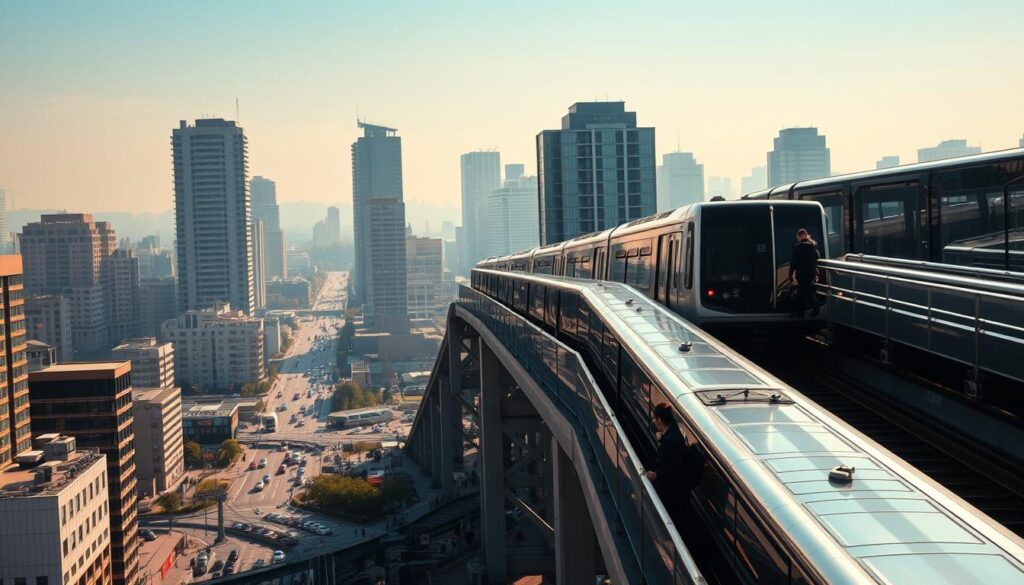
Skytrain Operations and Schedules
The Skytrain runs on a regular schedule. This makes planning your day simple. The train frequency changes with the time of day, with more trains during busy hours.
You can find the latest schedules on the Skytrain website or at stations. The Skytrain starts early and runs late. It’s a good idea to check the schedule before you go.
Fares and Payment Options
The Skytrain has different fare options. You can buy a single ticket or a reusable card. The reusable card can be used on other public transport too.
- Single-journey tickets are great for occasional trips.
- Rechargeable cards are convenient for frequent travel.
- Students, seniors, and regular commuters get special discounts.
Accessibility Features of Skytrains
The Skytrain is designed for everyone. Stations have elevators, escalators, and ramps for easy access.
Trains also have special areas for wheelchairs and seats for the elderly and disabled. Clear signs and announcements in many languages make travel better.
Exploring Tuk-Tuk Services
Tuk-tuks offer a thrilling way to see Thailand’s lively cities. As you move through the busy streets, you’ll get to know the local culture up close.
How to Hail a Tuk-Tuk
Finding a tuk-tuk is an adventure. They’re often near tourist spots, markets, or by waving on the street. Just wave to stop one and talk about the fare.
Tips for Hailing: Always negotiate the fare first. It helps to have your destination written in Thai to show the driver.
Fares and Negotiating Prices
Dealing with the fare is a big part of the fun. Make sure to agree on the price before you go. Here’s how to negotiate:
- Look up the average fare for your trip.
- Be ready to haggle; drivers often start high.
- Set the fare before you start.
Safety Considerations for Tuk-Tuks
While tuk-tuks are fun, safety comes first. Here are some tips:
- Wear a helmet if you can.
- Check the tuk-tuk is safe before you go.
- Don’t travel alone at night.
By following these safety tips, you can have a safe and fun tuk-tuk ride. This will help you make the most of your local travel tips and move around the city easily.
Local Transport Apps You Should Know
Explore the best local transport apps for Thailand. They can make your travel smoother. Having the right apps can save you time and help you navigate the country’s transport systems.

Best Apps for Real-Time Updates
Several apps offer real-time updates on metro, Skytrain, and more. Google Maps is a top choice for its detailed and current info. Moovit and Smart Traffic also offer accurate schedules and alerts.
Comparing App Features
When picking a transport app, consider a few key features. These include:
- Real-time tracking
- Route planning
- Service alerts
- Ease of use
Looking at these features across different apps helps you choose the best one for you.
User Reviews and Recommendations
User feedback is very helpful when choosing transport apps. For example, Grab is known for its quick tuk-tuk bookings. The BTS SkyTrain app is praised for its easy navigation.
By looking at user reviews and app features, you can pick the best local transport apps for your needs.
Essential Packing for Public Transit
Whether you’re a regular commuter or just visiting, knowing what to pack for public transit is key. The right items can make your journey smoother and more enjoyable.
Ideal Bags for Commuting
Choosing the right bag for your commute is important. It should be comfortable, practical, and secure. Look for a bag with multiple compartments to keep things organized.
- A sturdy backpack for carrying laptops and books
- A cross-body bag for easy access to your essentials
- A foldable tote for grocery shopping or other errands
Key Features to Look For:
- Padded straps for comfort
- Water-resistant material to protect against the elements
- Reflective details for increased visibility
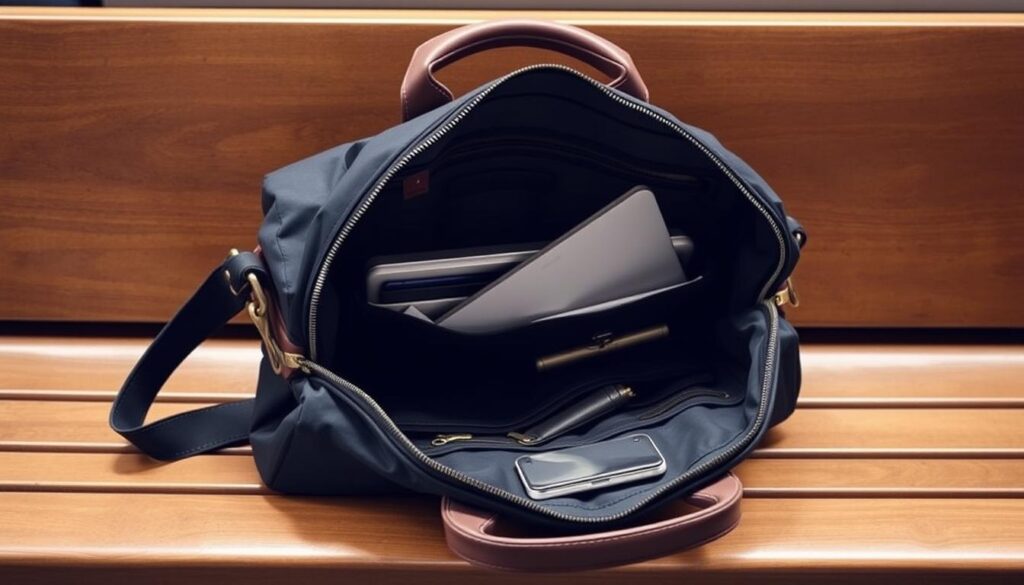
What to Bring for Comfort
Comfort is key when using public transit. The right items can make a big difference in your travel experience.
- A refillable water bottle to stay hydrated
- Snacks, such as energy bars or nuts, to keep your energy up
- A travel pillow or neck pillow for added comfort during longer journeys
Additional Comfort Tips:
- Dress in layers to adjust to changing temperatures
- Use noise-cancelling headphones to reduce ambient noise
- Download entertainment or reading material to keep you occupied
Safety Items to Consider
Safety is always a priority when commuting. There are several items you can bring to enhance your safety.
- A personal alarm that can be activated in case of an emergency
- A portable charger to ensure your phone stays charged
- Reflective clothing or accessories to increase your visibility
By being prepared with the right items, you can make your public transit experience safer, more comfortable, and enjoyable.
Local Transport Etiquette
Knowing the local transport etiquette is key to a pleasant journey. It makes your travel smoother and more enjoyable. Being aware of the unwritten rules helps a lot.
Courtesy Guidelines
Basic courtesy is important on public transport. Always give up your seat to those who need it more. This includes monks, pregnant women, and people with disabilities.
- Be mindful of your belongings and keep them secure to avoid disturbing others.
- Refrain from eating strong-smelling foods or making loud noises that could disturb fellow passengers.
- Offer your seat to those who are elderly, pregnant, or have disabilities.
Cultural Norms in Metro and Skytrain
It’s important to understand cultural norms on Metro and Skytrain. In many places, eating or drinking on public transport is seen as impolite. So, it’s best to avoid it.
Key cultural norms to be aware of:
- Respect for elderly passengers is deeply ingrained in many cultures.
- Avoid loud conversations or making unnecessary noise.
- Be prepared to follow specific rules or guidelines provided by transport staff.
Engaging with Drivers and Conductors
Being respectful and courteous when talking to drivers and conductors is vital. A simple greeting or thank you can make a big difference. It helps create a positive atmosphere.

- Be polite and respectful in your interactions.
- Follow their instructions or guidance.
- Express gratitude for their service.
Family-Friendly Transport Options
Traveling with your family is easier with the many transport options available. Whether you have babies, toddlers, or teenagers, knowing your transport choices can improve your trip.

Strollers and Wheelchairs on Public Transit
Public transport is designed for families with strollers or wheelchair users. You can move through metro stations and Skytrain platforms easily. Remember to fold your stroller in crowded areas or when boarding trains for a smooth journey.
Transport services have special areas for passengers with disabilities. This makes traveling with your family easier. Knowing about these features can greatly help.
Kid-Friendly Transport Tips
Traveling with kids needs some planning. Here are tips to make your trip better:
- Choose transport with plenty of space for strollers or luggage.
- Look for services with kid-friendly amenities, like play areas or family zones.
- Travel during off-peak hours to avoid crowded trains.
Planning ahead makes your family’s journey more enjoyable.
Family Pass Options
Many transport services have family pass options. These passes are cost-effective and convenient. They cover multiple family members for a set period. Exploring these options can save you money on your trip.
For family travel, buses or trains are great. They offer comfort, space, and good prices. You can travel with your family while enjoying the journey.
Transport Options After Dark
As night falls, knowing your transport options is key for a safe trip. Whether you’re a seasoned traveller or new to a city, navigating at night is important. It can make a big difference.
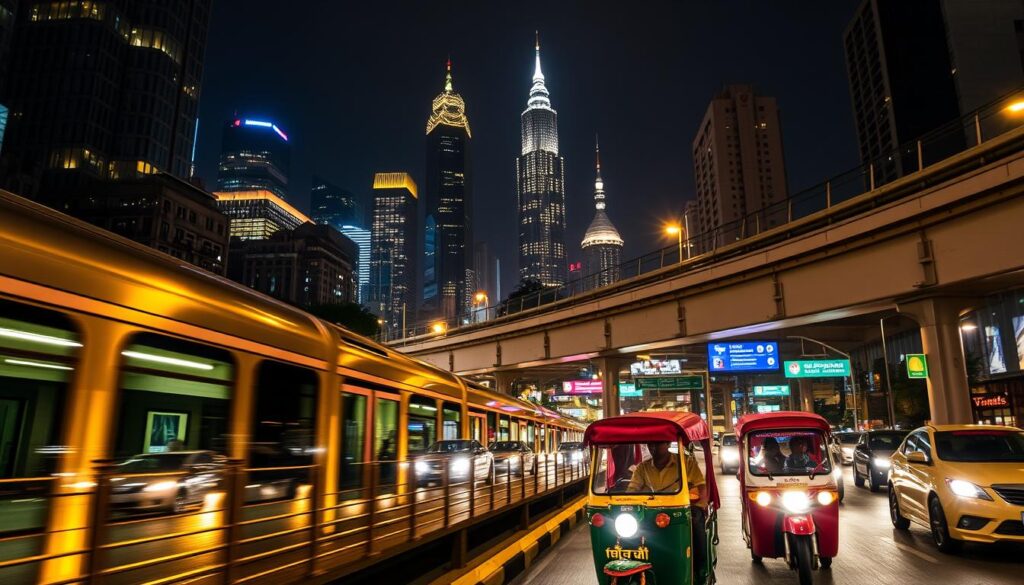
Nighttime Safety Tips
When using public transport at night, stay alert. Keep your belongings close and watch your surroundings. Stick to well-lit areas and avoid talking to suspicious people.
- Use licensed tuk-tuks or taxis from reputable companies.
- Keep your phone charged and accessible.
- Avoid displaying signs of wealth (e.g., expensive jewellery or watches).
Thailand is generally safe for tourists, but scams are common. Being careful and informed can help you avoid risks.
Late-Night Transport Choices
Many cities have late-night transport, like buses and trains. Check the local transport website or a reliable travel app for schedules and routes.
- Metro services often run late at night, with some cities open 24/7 on certain lines.
- Skytrain services usually stop around midnight, but times vary by city.
- Tuk-tuks and taxis are available all night, but agree on the fare first.
Local Resources for Assistance
If you have issues at night, seek help. Local tourist information centres can assist, and police stations are for emergencies.
- Keep a list of important phone numbers, including your country’s embassy and local emergency services.
- Download a local transport app for updates and support.
Eco-Friendly Transport Alternatives
Choosing greener transport can make a big difference for the planet. As more people care about the environment, there are more eco-friendly transport options available.
Using sustainable transport is good for the planet and makes your journey better. Here are some important points to think about:
Benefits of Sustainable Transport
Options like cycling and carpooling cut down on carbon emissions. They help make our environment cleaner and healthier. By picking these choices, you help:
- Reduce air pollution
- Lower greenhouse gas emissions
- Lessen traffic jams
Using Bicycles and Scooters
Cycling and scootering are great for short trips and are eco-friendly. Cities now have bike-sharing schemes and scooter lanes. This makes it easier and safer to travel.
Tips for cycling and scootering:
- Always wear a helmet and safety gear.
- Know the local cycling laws and rules.
- Use bike lanes when you can.
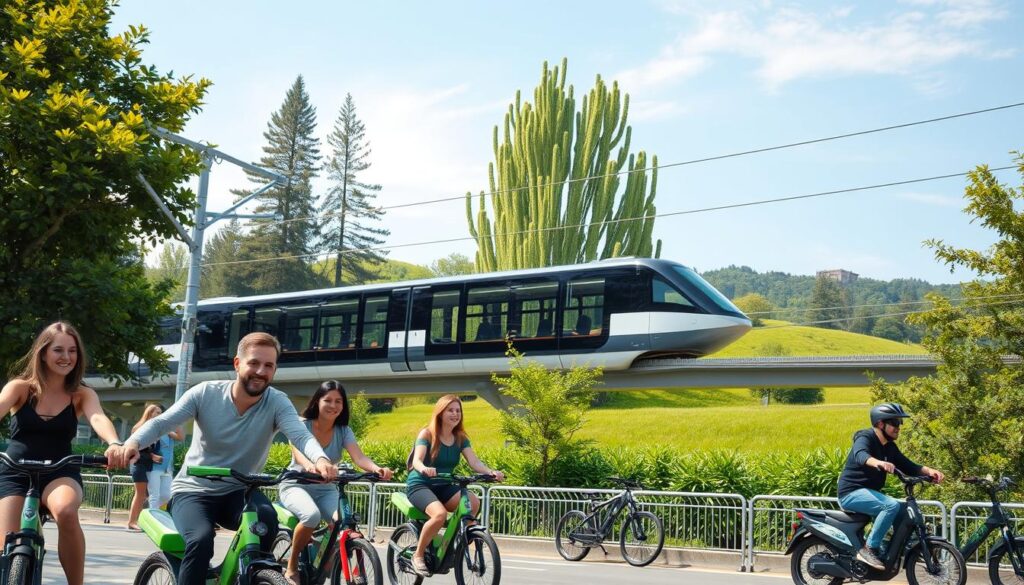
Carpooling and Rideshare Tips
Carpooling and ridesharing cut down on the number of cars on the road. This reduces emissions. To get the most out of these options:
- Use apps for carpooling and ridesharing to find others.
- Set a regular schedule for your carpool or rideshare.
- Be thoughtful of your travel mates about pick-up times, routes, and preferences.
Tourists: What You Need to Know
Exploring a new city can feel overwhelming. But, with the right transport info, you’ll soon feel like a local. As a tourist, you’ll likely use public transport. Knowing the local metro and Skytrain systems is essential.
Best Routes for Sightseeing
The Sukhumvit Line of the BTS is a must for tourists. It goes past many popular spots. You can visit shopping centres, night markets, and cultural sites using this line. Key stops to look out for include:
- Mo Chit: A major transport hub with connections to the north and northeast.
- Siam: The central interchange point for the BTS, allowing you to switch between lines.
- Phrom Phong: A bustling area with shopping and dining options.
- On Nut: Known for its lively night market.
Transport Discounts for Tourists
Many cities offer special deals for tourists. These can help you save money while exploring. Look for tourist passes that include transport, attractions, and sometimes dining or shopping discounts. You can buy these online or at local tourist info centres.
Some benefits of tourist passes include:
- Unlimited travel on public transport for a set period.
- Discounts on entry fees to popular attractions.
- Special offers at local restaurants and shops.
Guided Tours vs. Independent Travel
When exploring a new city, you can choose between guided tours or independent travel. Guided tours offer insights and easy navigation. Independent travel lets you set your own pace and make spontaneous stops.
Consider the following when deciding:
- Guided tours often include skip-the-line access and expert commentary.
- Independent travel allows you to explore at your own pace and make spontaneous stops.
- Some cities have hop-on hop-off bus tours that combine the benefits of both options.
Frequently Asked Questions About Local Transport
You now know about the local transport options like metro, Skytrain, and Tuk-Tuks. As you plan your trip, you might have more questions. This section answers common queries about local transport and gives you travel tips.
Common Queries on Routes and Fares
When using local transport, you might ask about the best routes or affordable travel. Most metro and Skytrain systems have online planners for quick routes. For Tuk-Tuks, setting a fare before starting can avoid confusion.
Essential Contact Information
If you need help from local transport services, most have customer service numbers and emails on their websites. You can also find help at major transport hubs.
Where to Find Further Assistance
For more help with local transport, check the official websites of transport providers or visit local tourist info centres. They have staff who speak many languages and can give great travel tips.
